maintenance VOLVO S90 2020 Quick Guide
[x] Cancel search | Manufacturer: VOLVO, Model Year: 2020, Model line: S90, Model: VOLVO S90 2020Pages: 643, PDF Size: 13.68 MB
Page 3 of 643
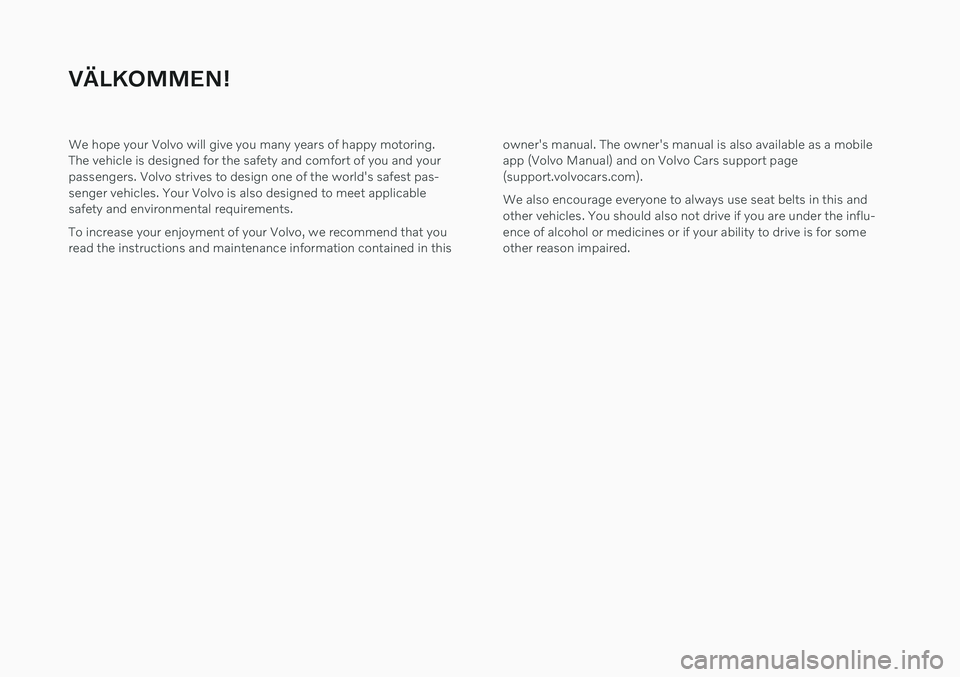
VÄLKOMMEN!
We hope your Volvo will give you many years of happy motoring. The vehicle is designed for the safety and comfort of you and yourpassengers. Volvo strives to design one of the world's safest pas-senger vehicles. Your Volvo is also designed to meet applicablesafety and environmental requirements. To increase your enjoyment of your Volvo, we recommend that you read the instructions and maintenance information contained in thisowner's manual. The owner's manual is also available as a mobileapp (Volvo Manual) and on Volvo Cars support page(support.volvocars.com). We also encourage everyone to always use seat belts in this and other vehicles. You should also not drive if you are under the influ-ence of alcohol or medicines or if your ability to drive is for someother reason impaired.
Page 9 of 643
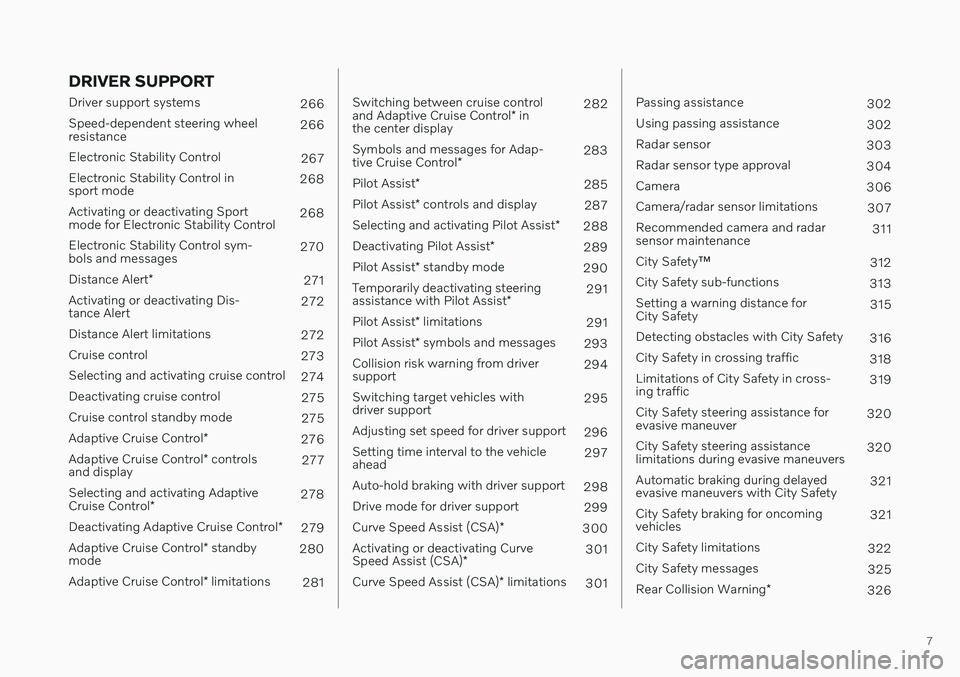
7
DRIVER SUPPORT
Driver support systems266
Speed-dependent steering wheel resistance 266
Electronic Stability Control 267
Electronic Stability Control insport mode 268
Activating or deactivating Sportmode for Electronic Stability Control 268
Electronic Stability Control sym-bols and messages 270
Distance Alert *
271
Activating or deactivating Dis-tance Alert 272
Distance Alert limitations 272
Cruise control 273
Selecting and activating cruise control 274
Deactivating cruise control 275
Cruise control standby mode 275
Adaptive Cruise Control *
276
Adaptive Cruise Control * controls
and display 277
Selecting and activating Adaptive Cruise Control * 278
Deactivating Adaptive Cruise Control *
279
Adaptive Cruise Control * standby
mode 280
Adaptive Cruise Control * limitations
281
Switching between cruise control and Adaptive Cruise Control * in
the center display 282
Symbols and messages for Adap-tive Cruise Control * 283
Pilot Assist *
285
Pilot Assist * controls and display
287
Selecting and activating Pilot Assist *
288
Deactivating Pilot Assist *
289
Pilot Assist * standby mode
290
Temporarily deactivating steeringassistance with Pilot Assist *291
Pilot Assist * limitations
291
Pilot Assist * symbols and messages
293
Collision risk warning from driver support 294
Switching target vehicles withdriver support 295
Adjusting set speed for driver support 296
Setting time interval to the vehicleahead 297
Auto-hold braking with driver support 298
Drive mode for driver support 299
Curve Speed Assist (CSA) *
300
Activating or deactivating Curve Speed Assist (CSA) * 301
Curve Speed Assist (CSA) * limitations
301
Passing assistance
302
Using passing assistance 302
Radar sensor 303
Radar sensor type approval 304
Camera 306
Camera/radar sensor limitations 307
Recommended camera and radar sensor maintenance 311
City Safety ™
312
City Safety sub-functions 313
Setting a warning distance forCity Safety 315
Detecting obstacles with City Safety 316
City Safety in crossing traffic 318
Limitations of City Safety in cross-ing traffic 319
City Safety steering assistance forevasive maneuver 320
City Safety steering assistancelimitations during evasive maneuvers 320
Automatic braking during delayedevasive maneuvers with City Safety 321
City Safety braking for oncomingvehicles 321
City Safety limitations 322
City Safety messages 325
Rear Collision Warning *
326
Page 11 of 643
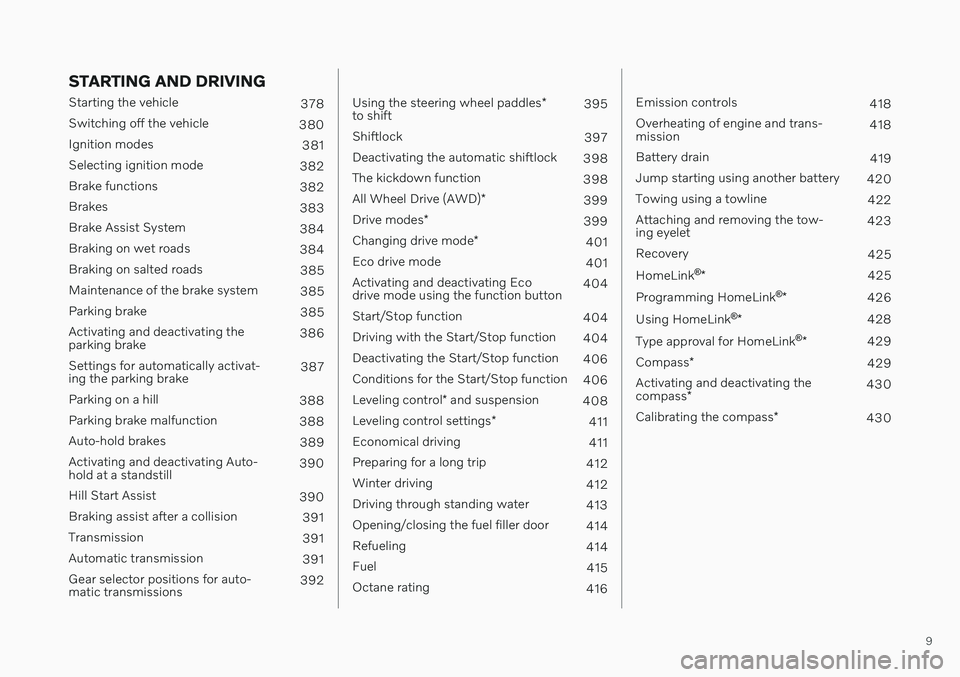
9
STARTING AND DRIVING
Starting the vehicle378
Switching off the vehicle 380
Ignition modes 381
Selecting ignition mode 382
Brake functions 382
Brakes 383
Brake Assist System 384
Braking on wet roads 384
Braking on salted roads 385
Maintenance of the brake system 385
Parking brake 385
Activating and deactivating the parking brake 386
Settings for automatically activat-ing the parking brake 387
Parking on a hill 388
Parking brake malfunction 388
Auto-hold brakes 389
Activating and deactivating Auto-hold at a standstill 390
Hill Start Assist 390
Braking assist after a collision 391
Transmission 391
Automatic transmission 391
Gear selector positions for auto-matic transmissions 392
Using the steering wheel paddles
*
to shift 395
Shiftlock 397
Deactivating the automatic shiftlock 398
The kickdown function 398
All Wheel Drive (AWD) *
399
Drive modes *
399
Changing drive mode *
401
Eco drive mode 401
Activating and deactivating Eco drive mode using the function button 404
Start/Stop function 404
Driving with the Start/Stop function 404
Deactivating the Start/Stop function 406
Conditions for the Start/Stop function 406
Leveling control * and suspension
408
Leveling control settings *
411
Economical driving 411
Preparing for a long trip 412
Winter driving 412
Driving through standing water 413
Opening/closing the fuel filler door 414
Refueling 414
Fuel 415
Octane rating 416
Emission controls418
Overheating of engine and trans- mission 418
Battery drain 419
Jump starting using another battery 420
Towing using a towline 422
Attaching and removing the tow-ing eyelet 423
Recovery 425
HomeLink ®
* 425
Programming HomeLink ®
* 426
Using HomeLink ®
* 428
Type approval for HomeLink ®
* 429
Compass *
429
Activating and deactivating the compass * 430
Calibrating the compass *
430
Page 14 of 643
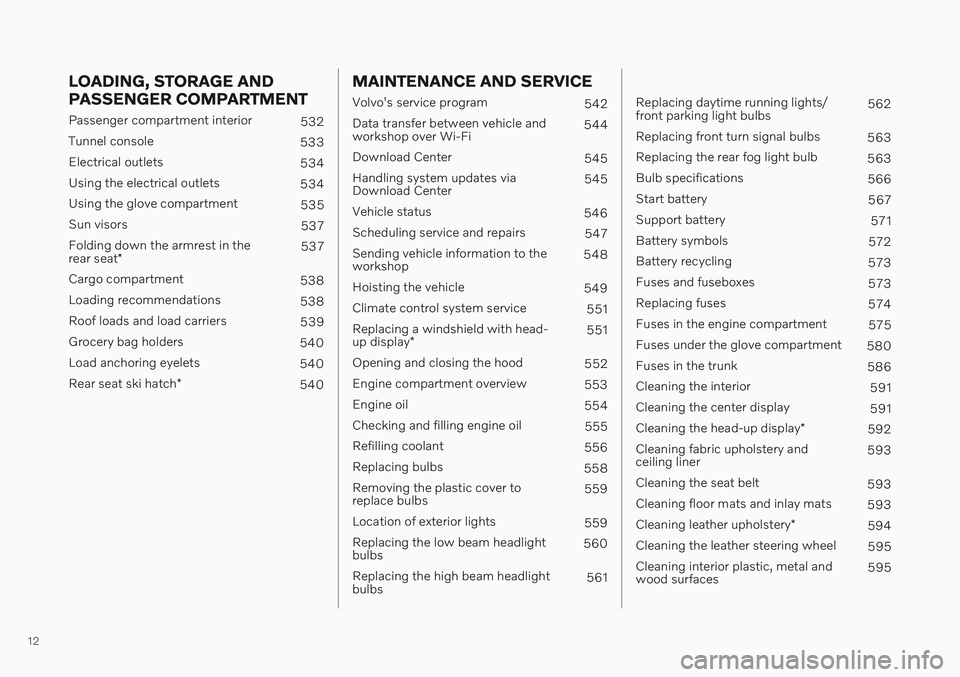
12
LOADING, STORAGE AND PASSENGER COMPARTMENT
Passenger compartment interior532
Tunnel console 533
Electrical outlets 534
Using the electrical outlets 534
Using the glove compartment 535
Sun visors 537
Folding down the armrest in the rear seat * 537
Cargo compartment 538
Loading recommendations 538
Roof loads and load carriers 539
Grocery bag holders 540
Load anchoring eyelets 540
Rear seat ski hatch *
540
MAINTENANCE AND SERVICE
Volvo's service program
542
Data transfer between vehicle and workshop over Wi-Fi 544
Download Center 545
Handling system updates viaDownload Center 545
Vehicle status 546
Scheduling service and repairs 547
Sending vehicle information to theworkshop 548
Hoisting the vehicle 549
Climate control system service 551
Replacing a windshield with head- up display * 551
Opening and closing the hood 552
Engine compartment overview 553
Engine oil 554
Checking and filling engine oil 555
Refilling coolant 556
Replacing bulbs 558
Removing the plastic cover to replace bulbs 559
Location of exterior lights 559
Replacing the low beam headlightbulbs 560
Replacing the high beam headlightbulbs 561
Replacing daytime running lights/ front parking light bulbs562
Replacing front turn signal bulbs 563
Replacing the rear fog light bulb 563
Bulb specifications 566
Start battery 567
Support battery 571
Battery symbols 572
Battery recycling 573
Fuses and fuseboxes 573
Replacing fuses 574
Fuses in the engine compartment 575
Fuses under the glove compartment 580
Fuses in the trunk 586
Cleaning the interior 591
Cleaning the center display 591
Cleaning the head-up display *
592
Cleaning fabric upholstery andceiling liner 593
Cleaning the seat belt 593
Cleaning floor mats and inlay mats 593
Cleaning leather upholstery *
594
Cleaning the leather steering wheel 595
Cleaning interior plastic, metal andwood surfaces 595
Page 30 of 643
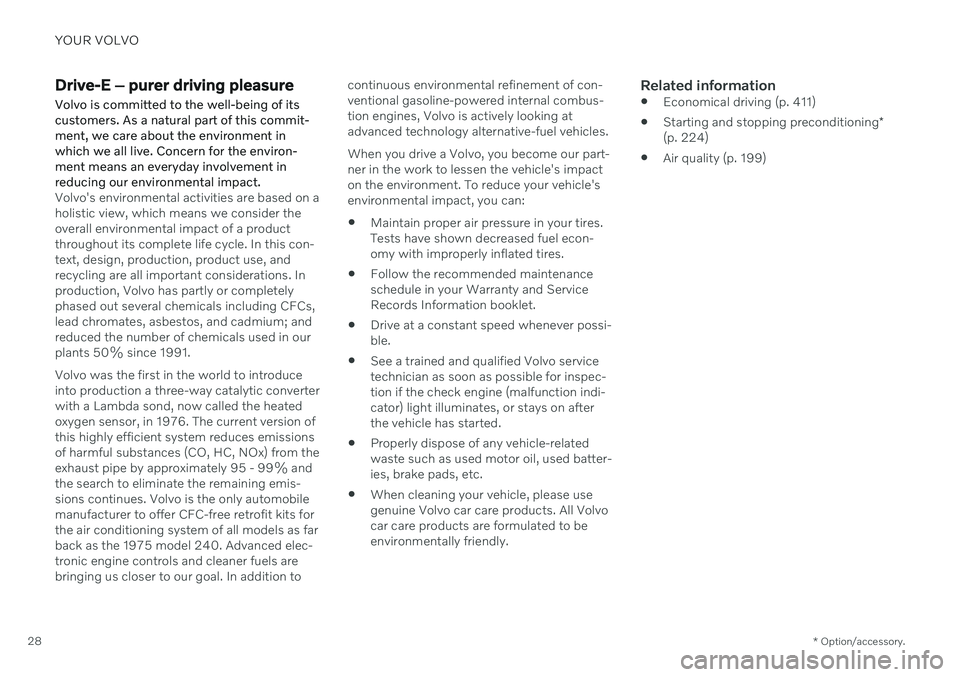
YOUR VOLVO
* Option/accessory.
28
Drive-E ‒ purer driving pleasure
Volvo is committed to the well-being of its customers. As a natural part of this commit-ment, we care about the environment inwhich we all live. Concern for the environ-ment means an everyday involvement inreducing our environmental impact.
Volvo's environmental activities are based on a holistic view, which means we consider theoverall environmental impact of a productthroughout its complete life cycle. In this con-text, design, production, product use, andrecycling are all important considerations. Inproduction, Volvo has partly or completelyphased out several chemicals including CFCs,lead chromates, asbestos, and cadmium; andreduced the number of chemicals used in ourplants 50% since 1991. Volvo was the first in the world to introduce into production a three-way catalytic converterwith a Lambda sond, now called the heatedoxygen sensor, in 1976. The current version ofthis highly efficient system reduces emissionsof harmful substances (CO, HC, NOx) from theexhaust pipe by approximately 95 - 99% andthe search to eliminate the remaining emis-sions continues. Volvo is the only automobilemanufacturer to offer CFC-free retrofit kits forthe air conditioning system of all models as farback as the 1975 model 240. Advanced elec-tronic engine controls and cleaner fuels arebringing us closer to our goal. In addition to continuous environmental refinement of con-ventional gasoline-powered internal combus-tion engines, Volvo is actively looking atadvanced technology alternative-fuel vehicles. When you drive a Volvo, you become our part- ner in the work to lessen the vehicle's impacton the environment. To reduce your vehicle'senvironmental impact, you can:
Maintain proper air pressure in your tires.Tests have shown decreased fuel econ-omy with improperly inflated tires.
Follow the recommended maintenanceschedule in your Warranty and ServiceRecords Information booklet.
Drive at a constant speed whenever possi-ble.
See a trained and qualified Volvo servicetechnician as soon as possible for inspec-tion if the check engine (malfunction indi-cator) light illuminates, or stays on afterthe vehicle has started.
Properly dispose of any vehicle-relatedwaste such as used motor oil, used batter-ies, brake pads, etc.
When cleaning your vehicle, please usegenuine Volvo car care products. All Volvocar care products are formulated to beenvironmentally friendly.
Related information
Economical driving (p. 411)
Starting and stopping preconditioning
*
(p. 224)
Air quality (p. 199)
Page 35 of 643

YOUR VOLVO
}}
33
Software Updates
So that you as a Volvo customer shall have the best possible experience from your car,Volvo is continuously developing the systemsin the cars and the services that you areoffered.
You can update the software in your Volvo to the latest version when your car is serviced atan authorized Volvo dealer. With the latestsoftware update, you can take advantage ofavailable improvements, including those thatcame with previous software updates. For more information about released updates and answers to frequently asked questions,please go to support.volvocars.com.
NOTE
Functionality after updating may vary depending on market, model, model yearand options.
Related information
Sensus - connection and entertainment (p. 30)
Handling system updates via DownloadCenter (p. 545)
Data recording As part of Volvo's commitment to safety and quality, certain information is recorded regar-ding vehicle operation, functionality and inci-dents.
US market only:
EDR
This vehicle is equipped with an "Event Data Recorder" (EDR). The main purpose of an EDRis to record, in certain crash or near crash-likesituations, such as an air bag deployment orhitting a road obstacle, data that will assist inunderstanding how a vehicle's systemsperformed. The EDR is designed to recorddata related to vehicle dynamics and safetysystems for a short period of time, typically 30seconds or less. The EDR in this vehicle isdesigned to record such data as:
How various systems in your vehicle wereoperating;
Whether or not the driver and passengersafety belts were buckled/fastened;
How far (if at all) the driver wasdepressing the accelerator and/or brakepedal; and,
How fast the vehicle was traveling.
These data can help provide a betterunderstanding of the circumstances in whichcrashes and injuries occur. NOTE: EDR dataare recorded by your vehicle only if a non- trivial crash situation occurs; no data arerecorded by the EDR under normal drivingconditions and no personal data (e.g., name,gender, age, and crash location) are recorded.However, other parties, such as lawenforcement, could combine the EDR datawith the type of personally identifying dataroutinely acquired during a crash investigation. To read data recorded by an EDR, special equipment is required, and access to thevehicle or the EDR is needed. In addition tothe vehicle manufacturer, other parties, suchas law enforcement, that have the specialequipment, can read the information if theyhave access to the vehicle or the EDR.
ASDR
This vehicle is equipped with an Active Safety Data Recorder (ASDR). This data recorder canrecord information related to the usage of thecar, functional errors and active safetyactuations (e.g. auto brake). The informationsaved is used by technicians for service andmaintenance to diagnose and repair possiblefaults that has occurred in the vehicle and tofulfil certain legal requirements. The registereddata can also, in congregated form, be usedfor research- and product development –purposes to continuously improve the safetyand quality of Volvo Cars. For moreinformation contact your local Volvo retailer.
Page 36 of 643

||
YOUR VOLVO
34Canadian market only: This vehicle is equipped with an “Event Data Recorder” (EDR). The main purpose of theEDR is to register and record data in trafficaccidents or accident-like situations, e.g. if anairbag deploys or if the vehicle hits an obstaclein the road. This data is recorded in order tohelp understand how the vehicle's systemsperform in these types of situations. The EDRis designed to record data related to vehicledynamics and safety systems for a shortperiod of time, usually 30 seconds or less. The EDR in this vehicle is designed to record data in traffic accidents or accident-like situa-tions such as:
How the various systems in the vehicleperformed;
Whether the driver and passenger seatbelts were tightened/buckled;
The driver's use of the accelerator/brakepedal;
How fast the vehicle was moving.
This data can help provide a better under-standing of the circumstances in which trafficaccidents and injuries occur. The EDR records data only if a non-trivial accident situation occurs. EDR does not record any data duringnormal driving conditions. The system alsonever registers data on who is driving the vehi-cle or the geographical location of the acci- dent or near-accident. However, other parties,such as law enforcement, could combine theEDR data with the type of personally identifia-ble information that is routinely acquired dur-ing an accident investigation. Special equip-ment and access to either the vehicle or theEDR is required to read this recorded data. In addition to the EDR, the vehicle is equipped with a number of computers that continuouslycontrol and monitor the vehicle's performance.These computers may record data during nor-mal driving conditions, particularly if theydetect a fault relating to the vehicle's opera-tion and functionality or upon activation of thevehicle's active driver support functions (e.g.City Safety or the auto-brake function). Some of this recorded data is required by technicians performing service and mainte-nance in order to diagnose and rectify anyfaults that may have occurred in the vehicle.The recorded information is also needed toenable Volvo to fulfill legal and other regula-tory requirements. Information registered inthe vehicle is stored in its computers until thevehicle is serviced or repaired. In addition to the above, the recorded informa- tion may be used in aggregated form forresearch and product development purposesin order to continuously improve the safetyand quality of Volvo vehicles.
Volvo will not provide this information to anythird parties without the vehicle owner's con-sent. However, national legislation and regula-tions may require Volvo to disclose this type ofinformation to law enforcement or otherauthorities that can claim a legal right to theinformation. Special technical equipment,which Volvo and workshops that have enteredagreements with Volvo have access to, isrequired to read and interpret the recordeddata. Volvo is responsible for ensuring thatinformation provided to Volvo in conjunctionwith service and maintenance is stored andhandled securely and in compliance withapplicable legal requirements. For more infor-mation, please contact a Volvo retailer.
Related information
Contacting Volvo (p. 26)
Volvo Structural Parts Statement (p. 39)
Page 37 of 643

YOUR VOLVO
}}
35
Terms & Conditions for Services
Volvo offers services that help enhance the vehicle's safety and comfort.
These services comprise everything from assistance in emergencies to navigation andvarious maintenance services. Before using the services, it is important to read support information about terms andconditions for the services atwww.volvocars.com.
Related information
Customer Privacy Policy (p. 35)
Customer Privacy Policy
Volvo respects and safeguards the personal privacy of everyone who visits our websites.
This policy refers to the handling of customer data and personal information. The purpose isto give current, past and potential customers ageneral understanding of:
The circumstances in which we collectand process your personal data.
The types of personal data we collect.
Why we collect your personal data.
How we process your personal data.
For more information on the policy, search forsupport information on www.volvocars.com.
Related information
Terms of use and data sharing (p. 486)
Terms & Conditions for Services (p. 35)
Data recording (p. 33)
Important information on accessories and extra equipment
Incorrectly connected or installed accessories or extra equipment may have an adverseeffect on the vehicle's electronics.
We strongly recommend that Volvo owners use only genuine, Volvo-approved accessories,and that accessory installations be performedonly by a trained and qualified Volvo servicetechnician. Certain accessories only workwhen the associated software is installed inthe vehicle's computer system. The equipment described in the Owner's Man- ual is not available in all vehicles. Vehicles maybe equipped differently depending on marketrequirements and national or local laws andregulations. Optional or accessory equipment may not be available in all countries or markets. Pleasenote that some vehicles may be equipped dif-ferently, depending on special legal require-ments. For more information on which equip-ment is standard and which is an option oraccessory, please contact your Volvo retailer.
Page 40 of 643
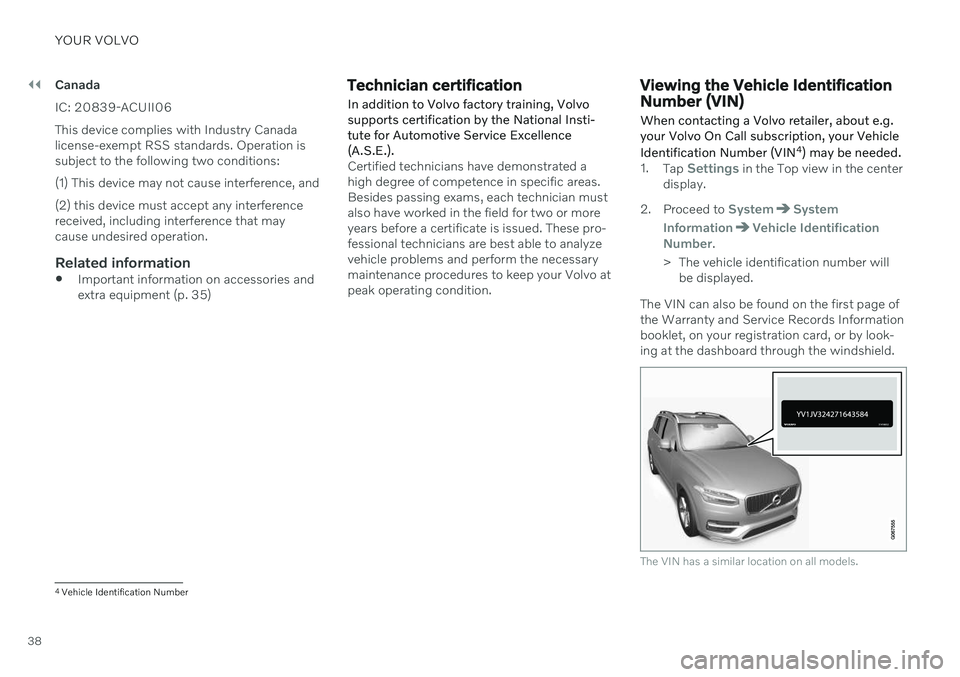
||
YOUR VOLVO
38Canada IC: 20839-ACUII06 This device complies with Industry Canada license-exempt RSS standards. Operation issubject to the following two conditions: (1) This device may not cause interference, and(2) this device must accept any interference received, including interference that maycause undesired operation.
Related information
Important information on accessories andextra equipment (p. 35)
Technician certification In addition to Volvo factory training, Volvo supports certification by the National Insti-tute for Automotive Service Excellence(A.S.E.).
Certified technicians have demonstrated a high degree of competence in specific areas.Besides passing exams, each technician mustalso have worked in the field for two or moreyears before a certificate is issued. These pro-fessional technicians are best able to analyzevehicle problems and perform the necessarymaintenance procedures to keep your Volvo atpeak operating condition.
Viewing the Vehicle Identification Number (VIN) When contacting a Volvo retailer, about e.g. your Volvo On Call subscription, your Vehicle Identification Number (VIN 4
) may be needed.
1. Tap Settings in the Top view in the center
display.
2. Proceed to
SystemSystem
Information
Vehicle Identification
Number.
> The vehicle identification number will be displayed.
The VIN can also be found on the first page of the Warranty and Service Records Informationbooklet, on your registration card, or by look-ing at the dashboard through the windshield.
The VIN has a similar location on all models.
4 Vehicle Identification Number
Page 49 of 643
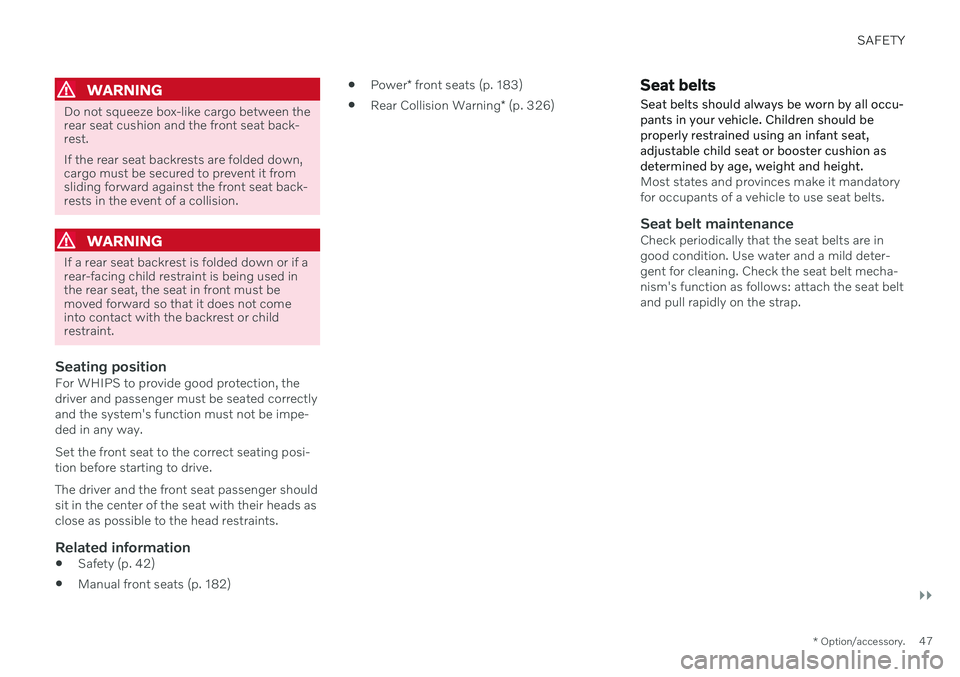
SAFETY
}}
* Option/accessory.47
WARNING
Do not squeeze box-like cargo between the rear seat cushion and the front seat back-rest. If the rear seat backrests are folded down, cargo must be secured to prevent it fromsliding forward against the front seat back-rests in the event of a collision.
WARNING
If a rear seat backrest is folded down or if a rear-facing child restraint is being used inthe rear seat, the seat in front must bemoved forward so that it does not comeinto contact with the backrest or childrestraint.
Seating positionFor WHIPS to provide good protection, the driver and passenger must be seated correctlyand the system's function must not be impe-ded in any way. Set the front seat to the correct seating posi- tion before starting to drive. The driver and the front seat passenger should sit in the center of the seat with their heads asclose as possible to the head restraints.
Related information
Safety (p. 42)
Manual front seats (p. 182)
Power
* front seats (p. 183)
Rear Collision Warning
* (p. 326)
Seat belts
Seat belts should always be worn by all occu- pants in your vehicle. Children should beproperly restrained using an infant seat,adjustable child seat or booster cushion asdetermined by age, weight and height.
Most states and provinces make it mandatory for occupants of a vehicle to use seat belts.
Seat belt maintenanceCheck periodically that the seat belts are ingood condition. Use water and a mild deter-gent for cleaning. Check the seat belt mecha-nism's function as follows: attach the seat beltand pull rapidly on the strap.